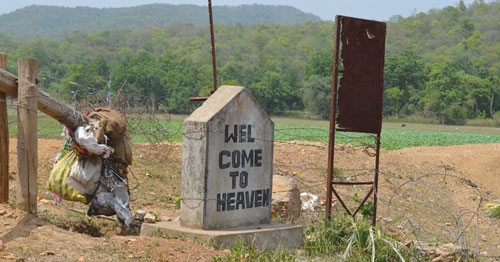It’s a route the government and the Chattisgarh police fear to tread. The base of the dreaded CPI (Maoist) naxalites and dotted with landmines, the forest makes even breathing difficult. The Goan travelled to an India that is unknown and not understood, to bring you a ground report from this most dangerous stretch of 56 kilometres in Sukma, in the Bastar region of Chattisgarh

It’s a forest without whispers. The huge swathe of sal andtoddy trees cut off all noise, including shrieks of death and the agony ofcapture. It’s an India that is not seen or heard. It’s a journey withoutprivileges. But if you survive the distance, it becomes one of deep learningand sadness.
Sukma is still is a small dot on the map of nothingness. Butit’s in the heart of Dandakarnaya, India’s most forested and most dreaded, thesanctum sanctorum of the terror territory of the CPI (Maoists). To the west of Sukma,(thedistrict headquarters) is Bijapur and then the Gardchiroli region ofMaharashtra. It caresses Malkangiri,Orissa to the east and down south after the block of Konta, arguably thereddest of the red terror blocks, is the road to Andhra Pradesh.
It on this route where the Naxals have struck the most,killing their class enemies – the armed forces from the police to the CRPF aswell as their new mass enemies, the tribals of the land, who their ideologyseeks to protect. Since 2004, a retaliation movement of tribals led by leaderMahendra Karma, ultimately christened the Salwa judum movement, reacted toNaxal activities and led a counter attack. The state then stepped in to protectthem and moved them out of theirvillages to other safe villages and camped them. The Salwa Judum camps thenbecame targets of attack. On July 17, 2006, in Errabore village on the road to Konta, 33 people were massacredincluding two four year olds who were burnt alive.
It’s terror country all right. From Sukma to Dornapal, the30 kms, treacherous NH 43, with pot holes that erupt into a rash through theroute takes close to two hours. Dornapal is the last point of civilisationbefore you head to-if you dare to and if you can- through the heart ofdarkness. A 56 kilometre stretch, where the police and the government hardlydare to enter. This is the zone of the South Bastar District Committee of theCPI(Maoists), under the Dandakarnya Special Zone. Dotted with small villagesand hamlets, some not even seen, the villages of Pollampalli, Chintal Gufa,Chintalnar, Tadmetla and finally Jagargunda are names that are on top of themind recall of any counter intelligence officer. But very few reach them. TheGoan did.
At Dornapal, the 47 degree heat has made the whirling fansin the panchayat office heat dispensers. Above the noise, an officer looksbemused when he hears that this reporter was planning a trip to the reddest ofthe red zones. ‘Hah, you won’t even go beyond 12 kilometres, the road iscompletely broken, there are forest paths but you’ll get lost and there areland mines everywhere. Why are you going? Even the police don’t go there”
That wasn’t a deterrent. We went in and crossed the firstvillage on the 56 kilometer jungle route – Pornapalli. Over yonder culverts werebroken, light poles uprooted by the Naxals – a potent sign, if ever there wasone needed, of the lengths to which they would go to keep the Dandakarnayaforests in eternal darkness. After Pornapalli, it was a battle between us andthe jungles. We made paths where they weren’t any. We removed stones andbranches and moved on taking diversions and detours, losing our way often. Wedidn’t even have the sun for company, covered by the thick foliage. We inchedon, at ten kilometres an hour crossing one desolate forest village after other.
At Chintal Gufa, we saw a strange sight – clothes hangingfrom a tree, an umbrella too. In the clearing, there was a pit of ash andskeletal remains, a makeshift cremation ground for the critically ill orinjured who die on their way from the remote Naxal affected villages to thenearest road head. With health centers and facilities destroyed, patients needto walk or be carried for close to fifty kilometres for treatment. Many don’tsurvive. Beyond Chintal Gufa, the first signs of the ‘state’. A CRPF camp atChintalnar, with a milestone on with an uncanny sign, “Welcome to heaven”. Yet another irony. 76 jawans from this verycamp were massacred to death in the next village Tadmetla by Naxals in April2006 and it was right here that the Collector of Sukma, IAS officer Alex PaulMenon was released from captivity after talks with government mediators. We crawled on, finding our way, defying theAdditional DG (Anti Naxal operations) Ram Niwas’ statement that only twowheelers can move here. We tested the limits of our car beyond imagination. Wesurvived.
The last stretch of 12 kilometres to Jogargunda was theworst. Literally the last post, there is no village beyond. Just the forests.Jogargunda is a ghost village, with remnants of a past civilization. Armedguards stood over the debris of broken forest offices, health centers, schoolbuildings and homes. All bombed and broken by naxals. This is where Sukma and Syria meet. In thedebris, there isn’t even an ember of hope. In the quiet you realise how Maoistshave destroyed a civilisation that their ideology claims to protect.
On the way to Jogargunda, we say a banner signed by the“Jogargunda Area Committee of the CPI (Maoists) asking people to protestagainst the centres proposal for an NCTC (National Counter terrorism Centre).The hypocrisy was stark. Jogarguda has been striped, broken and deserted byterrorists who have plunged Bastar, further into the heart of darkness.